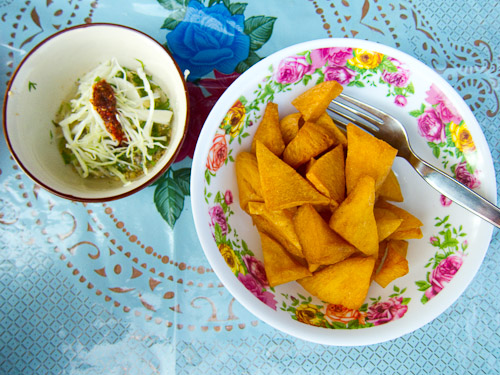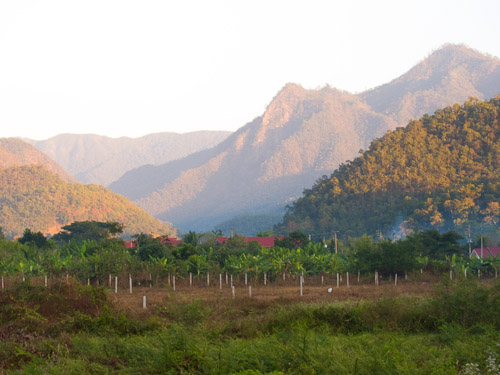 As mentioned previously, people in northern Thailand love their deep-fried food. And in a weird twist of fate, one kind of deep-fried snack that’s particularly popular in Mae Hong Son is also associated with the streets of Sicily.
As mentioned previously, people in northern Thailand love their deep-fried food. And in a weird twist of fate, one kind of deep-fried snack that’s particularly popular in Mae Hong Son is also associated with the streets of Sicily.
Known there as panelle, in Mae Hong Son they’re sometimes called tao huu thawt, literally ‘fried tofu.’ This is a misleading name, as the crispy deep-fried snacks are actually made from chickpea (garbanzo bean) flour.
An obscure ingredient that I’ve only ever encountered here in Mae Hong Son or in Indian groceries (where it’s known as besan), chickpea flour is also popular in Myanmar, particularly among the Shan, the same Tai ethno-linguistic group that inhabit Mae Hong Son, who use it to make something the Burmese call Shan tophu kyaw, ‘deep-fried Shan tofu,’ a dish that outsiders sometimes call Burmese tofu.
The vendors in Mae Hong Son’s morning market sell a variety of dishes using chickpea flour. In one, known as thua oon, ‘warm beans,’ the flour is boiled with water, and the thick, yellow, gelatinous liquid is served over noodles. In another version, the flour and water mixture are allowed to set until firm enough to cut into slices which are eaten in the form a spicy salad.
But the tastiest and seemingly most popular version is thua phu thawt, ie the panelle of Mae Hong Son, where the firm mixture is deep-fried. They’re light and rarely oily, and when hot, actually taste a lot like McDonald’s French fries. In Sicily they’re fried in wide, flat sheets and are apparently served in sandwiches. In Mae Hong Son’s morning market, they’re served as tiny triangles and come with a spicy/salty tamarind-based dip.
Recently a vendor started selling the dish near the house I rent up here. Her version, like those sold in Myanmar, are small and crispy, and are served with a dip that combines chickpea flour paste, lime juice and chili oil (pictured at the top of this post).
This snack and view from the vendor's stall:
are collaborating to take me from my work and make me fat.
Is there a link between the panelle of Sicily and the thua phu thawt of Mae Hong Son? My only guess is the Muslim influence that came to Sicily via the Moors and to Myanmar via India, brought with it chickpea flour. The fried dish that exists today in these disparate destinations could very well be a culinary coincidence.
If you want to make thua phu thawt, pick up a bag of besan at an Indian grocery and follow this Italian recipe. If you're in Mae Hong Son, simply go here:
View Thai Eats in a larger map












